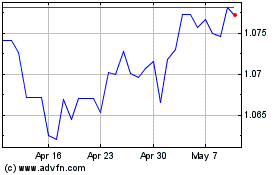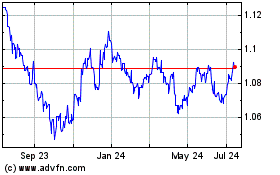Blockbuster Jobs Report Reverses The U.S. Dollar's Slide
February 06 2023 - 4:13AM
RTTF2
Currency exchange rates whipsawed in the week of January 30 -
February 3 amidst the Fed's monetary policy pronouncements on
Wednesday acknowledging the abatement in inflation, and the
stunning jobs report on Friday reiterating the strength of the
labor market.
The week started off on strong expectations that the Fed would
ease its monetary policy, triggering the Dollar's weakness. The
Dollar Index (DXY) which measures the Dollar's strength against a
basket of 6 currencies opened the week at 101.92 and touched a low
of 101.04 by Wednesday. The Federal Reserve's as-expected 25-basis
points rate hike, a dovish commentary and the Fed Chair's
acknowledgement that a disinflationary process had started in the
economy exacerbated the Dollar's slide, causing the DXY to fall
further to a weekly low of 100.82 by Thursday.
But the strength of the jobs market was beyond what markets had
expected. The non-farm payrolls addition in January that markets
expected to be 185 thousand, versus 260 thousand in the previous
month came in at 517 thousand, potentially throwing a spanner into
the Fed's easing plans. The unemployment rate fell to 3.4 percent
from 3.6 percent earlier. The ISM Non-manufacturing PMI surging
beyond expectations to 55.2, denoting expansion, implied a robust
services sector.
The fear that the strength of the U.S. economy could cause
interest rates to continue to remain high for a longer period
lifted the Dollar, and the Dollar Index surged to a weekly high of
103.01 on Friday, before finally ending the week a tad lower at
102.92. The DXY gained 0.97 percent in a span of 7 days.
The European Central Bank's as-expected 50-basis-points rate
hike and hints of a similar dose in the next review helped the Euro
stay strong. The EUR/USD pair which had closed on January 27 at
1.0867, strengthened to a high of 1.1034 by Thursday, aided by the
ECB's stated commitment to continue the inflation combat by keeping
interest rates sufficiently restrictive. But the vastly higher jobs
data from the U.S. bolstered sentiment in favor of the U.S. Dollar
causing the pair to drop to the week's low of 1.0791 on Friday,
before ending the week at 1.0793. The pair shed 0.68 percent during
the week.
The British pound depreciated close to 3 percent to the U.S.
Dollar amidst the Bank of England's unexpected hints of a policy
pivot. Alongside the expected rate hike of 50 basis, the Bank of
England's omission of the word "forcefully' from its forward
guidance triggered bets that the BoE was near the end of its hiking
cycle. This caused the sterling to weaken in the currency market.
The GBP/USD pair which had closed on January 27 at 1.2397, finished
trading on Friday, February 3 at 1.2051 after touching an
intra-week high of 1.2419 and an intra-week low of 1.2047.
The yen which maintained a rising trend against the Dollar
during the course of the week, weakened on Friday, overwhelmed by
the rebound in the Dollar post the higher-than-expected jobs data.
The USD/JPY pair which had opened on January 30 at 129.71 dropped
to as low as 128.08 on Thursday before the jobs data surprise
lifted the Dollar, causing the pair to rise to 131.24. Between
January 27's closing level of 129.85 and the closing level of
131.17 on February 3, the pair increased more than 1 percent.
The AUD/USD pair too mirrored the payroll tumble in other major
currencies, strengthening to the highest level of 0.7158 by
Thursday before dropping to the weekly low of 0.6919 on Friday
after the jobs data. The pair moved from 0.7103 to 0.6919 between
January 27 and February 3, decreasing more than 2.5 percent during
the week.
The Dollar's strength after the jobs data and PMI readings on
Friday has been further reinforced with the escalation in tensions
between China and the U.S. The Dollar Index has since strengthened
to 103.38. The Euro depreciated to $1.0760, while the pound is
currently at $1.2046. The Australian Dollar is currently trading at
$0.6886 ahead of the Reserve Bank of Australia's interest rate
review on Tuesday. The USD/JPY pair has increased to 132.52 amidst
reports that a dovish candidate is being proposed as the successor
to the Bank of Japan's top role.
Euro vs US Dollar (FX:EURUSD)
Forex Chart
From Mar 2024 to Apr 2024

Euro vs US Dollar (FX:EURUSD)
Forex Chart
From Apr 2023 to Apr 2024
